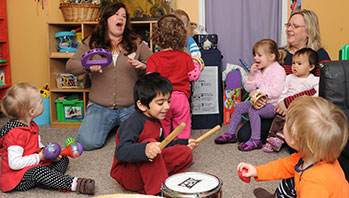- communicate
- sound
MA Standards:
Speaking and Listening/SL.PK.MA.1a: Observe and use appropriate ways of interacting in a group (e.g., taking turns in talking, listening to peers, waiting to speak until another person is finished talking, asking questions and waiting for an answer, gaining the floor in appropriate ways).
MA Draft STE Standards:
Physical Sciences/Matter and Its Interactions/PS4.B: Apply their understanding in their play of how to change volume and pitch of some sounds.
Head Start Outcomes:
Social Emotional Development/Self-Regulation: Follows simple rules, routines, and directions.
Language Development/Receptive Language: Attends to language during conversations, songs, stories, or other learning experiences.
PreK Learning Guidelines:
English Language Arts/Language 1: Observe and use appropriate ways of interacting in a group (taking turns in talking; listening to peers; waiting until someone is finished; asking questions and waiting for an answer; gaining the floor in appropriate ways).
English Language Arts/Reading and Literature 12: Listen to, recite, sing, and dramatize a variety of age-appropriate literature.
Sing Together: “The Wheels on the Bus” #1

© Commonwealth of Massachusetts, Department of Early Education and Care (Jennifer Waddell photographer). All rights reserved.
STEM Key Concepts: Sounds have a source; An action has to happen to make a sound; Different objects make different sounds
ELA Focus Skills: Follow Directions, Gross Motor Skills, Speaking and Listening, Phonological Awareness
- Point out that some of the sounds they will sing about are made from different parts of the bus, but other sounds are made from people.
- Talk about how people use sounds to communicate, or share information with one another.
Sing the song and have children join you in acting out each verse. Discuss the different sounds made on the bus.
- See if children are able to identify what or who is making the sound.
- Ask, Can you tell what or who is making the sound? Have you ever heard these sounds before? When?
Have the children think about other sounds they might hear on the bus and create new verses using their ideas. Encourage them to include sounds of people communicating, such as, A man on the bus says “ZZzzzz, zzzzzz, zzzzzz” (The sound communicates he's sleeping!).
The Wheels on the Bus
The wheels on the bus go round and round,
Round and round, round and round.
The wheels on the bus go round and round
All through the town. (roll hands over each other)
The wipers on the bus go “Swish, swish, swish,
Swish, swish, swish, swish, swish, swish.”
The wipers on the bus go “Swish, swish, swish”
All through the town. (put arms together in front of you and swish like windshield wipers)
The horn on the bus goes “Beep, beep, beep,
Beep, beep, beep, beep, beep, beep.”
The horn on the bus goes “Beep, beep, beep”
All through the town. (pretend to honk horn)
The money on the bus goes “Clink, clink, clink,
Clink, clink, clink, clink, clink, clink.”
The money on the bus goes “Clink, clink, clink”
All through the town. (pretend to put money in cash box on bus)
The baby on the bus says, “Wah, wah, wah!
Wah, wah, wah! Wah, wah, wah!”
The baby on the bus says, “Wah, wah, wah!”
All through the town. (rub eyes with fists like a baby)
The people on the bus say, “Shh, shh, shh,
Shh, shh, shh, shh, shh, shh,”
The people on the bus say, “Shh, shh, shh”
All through the town. (put pointer finger to mouth to shhh)
